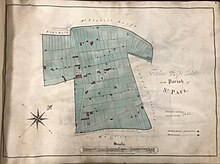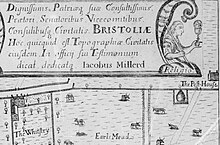74:
20:
57:. By 1828 the estate had been divided into a number of smaller properties and gardens. During the 1870s the estate was then thoroughly redeveloped, with a new road layout, as part of the urban development of Bristol. The 'Forlorn Hope Estate' was a separate charity until 2004, the assets now being part of St Nicholas with St Leonard Educational Charity. As such, it still exists as a legal entity, with the proceeds of the estate being employed for religious education in schools and youth organisations within the Bristol.
61:
89:. It seems to have been a proper quarantine hospital by the standards of its time, supervised by the surgeon Dr John Dunbar, who was later granted Freedom of the City, along with a financial reward ‘for his late faithfull service at the Pesthouse in the time of Infection to the greate hazard of his life’. Food, medicine and accommodation, including temporary huts with sailcloth roofs, were provided. Additional medical support was probably offered by the noted physician,
97:
131:
The
Forlorn Hope Estate, or part of it, was described as 'Langsdown's Land' in the 1373 Charter establishing Bristol as a county. It was sometimes also known as Riglings, Ridglings, or Ragland's. While the origin of the name 'Forlorn Hope' is obscure, it predates its use as a pesthouse, in that the
139:. This was a detached body of soldiers sent ahead of a main attacking force to trigger traps set by defenders. Forlorn Hope House may have got its name because it was the most isolated dwelling house in the city and county of Bristol, situated on a tongue of land extending up the west bank of the
118:
The
Pesthouse remained in operation until at least 22 September 1666, when the mayor and aldermen decided to curtail their annual perambulation of the boundaries of the city and county, to view the 'shirestones' because this would require them to pass through the estate twice, going within fifty
104:
The establishment of the
Forlorn Hope Pest House was key to Bristol's attempts to limit the spread of Plague within Bristol in 1666. Unlike London, where 100,000 people died, only about 100 people (
143:. The house is marked, but not named, on John Rocque's 1743 plan of Bristol, which was the first to include all the county, including the location of the shirestones and the county boundary.
351:
The
Bristol Charities, being the report of the commissioners for inquiring concerning charities in England and Wales, so far as relates to the charitable institutions in Bristol
81:
In
December 1665 the main property on the estate, the ‘house called the Forlorne Hope’, was leased by the Corporation along with its lands, to serve as Bristol's
119:
metres of the
Pesthouse. The property was probably retained by the Corporation after this time, ‘The Pest-House’ being depicted in James Millerd’s 1673 map
393:
297:
University of
Bristol Press Release, 'History student uncovers new details about 17th century plague hospital in Bristol' (21 September 2021)
200:
185:
212:
93:, who later provided an account of his medical practice and treatment of people in Bristol during the Plague outbreak of 1665–6.
132:
main property was described as 'the house called the
Forlorne Hope' in 1665 at the time it was leased by Bristol Corporation.
442:
43:
vestry from 1693. At that time it consisted of a main dwelling house, stables, associated buildings and gardens of
437:
378:
447:
296:
348:
333:
40:
452:
432:
86:
112:
363:
307:
281:
253:
238:
223:
159:
140:
8:
213:
Charity
Commission of England and Wales 'St Nicholas with St Leonard Educational Charity'
36:
174:
322:
73:
90:
426:
408:
395:
19:
136:
96:
82:
111:
of the population) died in
Bristol. Dr Evan Jones, a historian at the
60:
164:(Bristol Record Society electronic publication, September 2021) p. 26
338:(Bristol Record Society publications, Vol. I, Bristol, 1930), p. 161
32:
201:
Charity Commission for England and Wales 'Forlorn Hope Estate'
162:
Documents Relating to the Great Plague of 1665-1666 in Bristol
115:
suggests that for that the city could thank the Forlorn Hope.
353:
Vol. II (T. J. Manchee, Bristol, 1832), pp. 178-9, 215
39:. The 13-acre estate was originally a farm owned by
135:The name may be a humorous reference to a military
121:
An exact delineation of the famous city of Bristoll
64:
Forlorn Hope Estate with modern (2023) street plan.
424:
77:The Pest House on Millerd's 1673 Plan of Bristol
95:
72:
59:
18:
425:
366:Documents Relating to the Great Plague
310:Documents Relating to the Great Plague
284:Documents Relating to the Great Plague
256:Documents Relating to the Great Plague
241:Documents Relating to the Great Plague
226:Documents Relating to the Great Plague
188:Documents Relating to the Great Plague
175:Plan of the Forlorn Hope Estate (1828)
23:Plan of the Forlorn Hope Estate (1828)
126:
383:(Bristol, 1743), bottom-right sheet.
323:James Millerd's 1673 Plan of Bristol
13:
16:Estate in Bristol with a pesthouse
14:
464:
68:
372:
357:
342:
327:
316:
301:
290:
275:
262:
247:
232:
217:
206:
194:
179:
168:
153:
85:following the outbreak of the
1:
334:Norah Dermott Harding (ed.),
146:
105:
51:
44:
7:
381:Plan of the City of Bristol
349:Thomas John Manchee (ed.),
336:Bristol Charters, 1155-1373
10:
469:
443:Isolation (health care)
272:(London, 1673), p. 238.
101:
87:Great Plague of London
78:
65:
24:
438:Quarantine facilities
113:University of Bristol
99:
76:
63:
22:
448:Hospitals in Bristol
409:51.46444°N 2.58000°W
270:A friend to the sick
141:River Frome, Bristol
405: /
29:Forlorn Hope Estate
414:51.46444; -2.58000
160:Alex Beard (ed.),
127:Origin of the Name
102:
79:
66:
41:St Nicholas Church
25:
453:St Pauls, Bristol
55: 10.5 acres
50:, plus fields of
460:
433:Plague (disease)
420:
419:
417:
416:
415:
410:
406:
403:
402:
401:
398:
385:
376:
370:
361:
355:
346:
340:
331:
325:
320:
314:
305:
299:
294:
288:
279:
273:
268:William Sermon,
266:
260:
251:
245:
236:
230:
221:
215:
210:
204:
198:
192:
183:
177:
172:
166:
157:
110:
107:
56:
53:
49:
48: 2.5 acres
46:
468:
467:
463:
462:
461:
459:
458:
457:
423:
422:
413:
411:
407:
404:
399:
396:
394:
392:
391:
389:
388:
377:
373:
362:
358:
347:
343:
332:
328:
321:
317:
306:
302:
295:
291:
280:
276:
267:
263:
252:
248:
237:
233:
222:
218:
211:
207:
199:
195:
184:
180:
173:
169:
158:
154:
149:
129:
108:
71:
54:
47:
17:
12:
11:
5:
466:
456:
455:
450:
445:
440:
435:
387:
386:
371:
356:
341:
326:
315:
300:
289:
274:
261:
246:
231:
216:
205:
193:
178:
167:
151:
150:
148:
145:
128:
125:
91:William Sermon
70:
69:The Pest House
67:
31:is an area of
15:
9:
6:
4:
3:
2:
465:
454:
451:
449:
446:
444:
441:
439:
436:
434:
431:
430:
428:
421:
418:
384:
382:
379:John Rocque,
375:
369:
367:
360:
354:
352:
345:
339:
337:
330:
324:
319:
313:
311:
304:
298:
293:
287:
285:
278:
271:
265:
259:
257:
250:
244:
242:
235:
229:
227:
220:
214:
209:
202:
197:
191:
189:
182:
176:
171:
165:
163:
156:
152:
144:
142:
138:
133:
124:
122:
116:
114:
100:Millerd's map
98:
94:
92:
88:
84:
75:
62:
58:
42:
38:
34:
30:
21:
390:
380:
374:
365:
359:
350:
344:
335:
329:
318:
309:
303:
292:
283:
277:
269:
264:
255:
249:
240:
234:
225:
219:
208:
196:
187:
181:
170:
161:
155:
137:Forlorn Hope
134:
130:
120:
117:
103:
80:
28:
26:
412: /
109: 0.5%
427:Categories
397:51°27′52″N
190:, pp. 27-8
147:References
83:pest house
400:2°34′48″W
258:, pp. 2-3
37:St Paul's
368:, p. 39
364:Beard,
312:, p. 57
308:Beard,
282:Beard,
254:Beard,
239:Beard,
228:, p. 39
224:Beard,
186:Beard,
33:Bristol
286:, p. 1
243:, p. 2
27:The
35:in
429::
123:.
106:c.
52:c.
45:c.
203:.
Text is available under the Creative Commons Attribution-ShareAlike License. Additional terms may apply.



